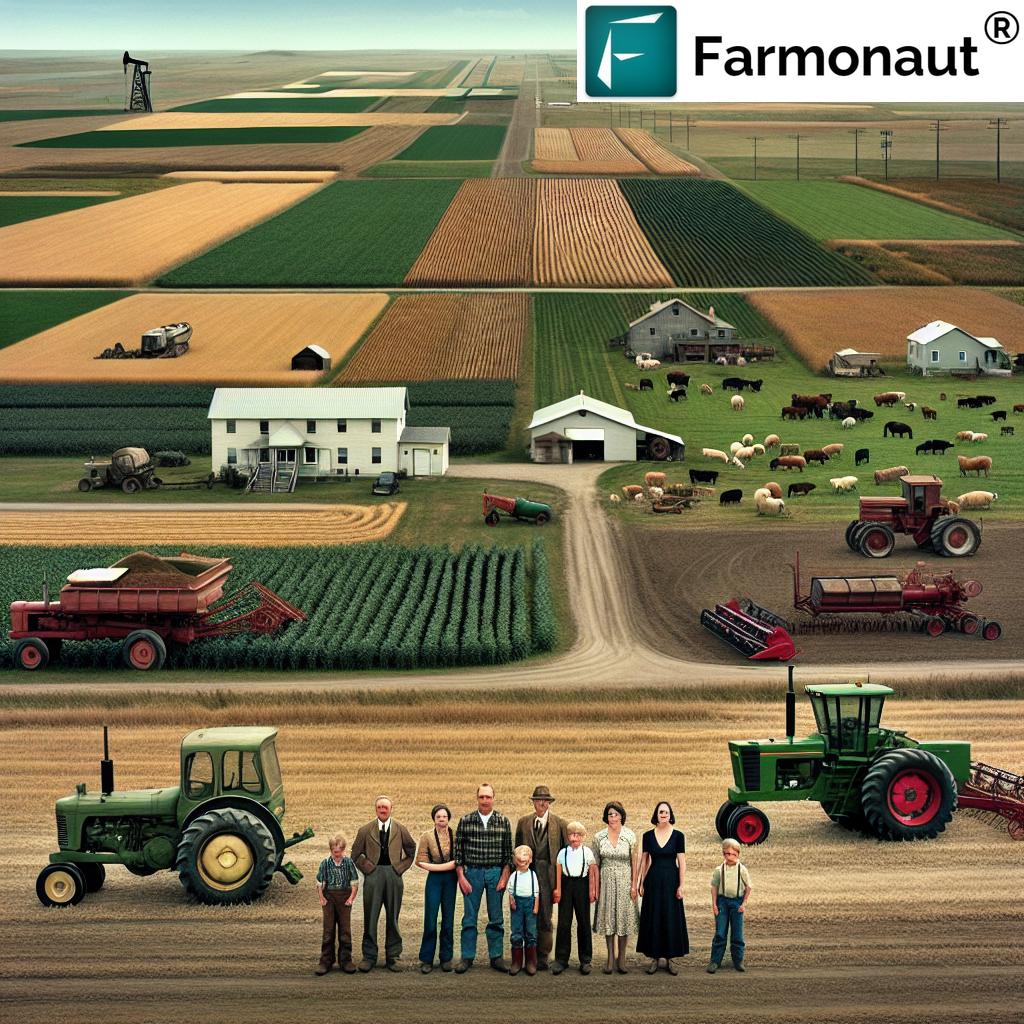North Dakota Farm Legacy: A Tribute to Embden’s Agricultural Pioneer and Community Leader
“North Dakota’s agricultural legacy spans over 150 years, with Fargo becoming a major hub for farming innovation and community leadership.”
In the heart of America’s heartland, North Dakota stands as a testament to the enduring spirit of agriculture and the unwavering dedication of its farmers. Today, we pay tribute to one such remarkable individual who exemplified the very essence of North Dakota farming and left an indelible mark on the community of Embden and beyond. Lyle F. Schultz, a true agricultural pioneer and community leader, passed away on March 10, 2025, at the age of 85, leaving behind a legacy that will continue to inspire generations of farmers and shape the landscape of North Dakota agriculture.
Early Years and the Seeds of a Farming Legacy
Born on June 23, 1939, in Fargo, North Dakota, Lyle Schultz was destined for a life intertwined with the land. Raised by Carl and Caroline (Zick) Schultz, young Lyle was baptized and confirmed at St. John Lutheran Church in Embden, laying the foundation for his strong faith and community involvement that would characterize his entire life.
Lyle’s journey in agriculture began in earnest after his graduation from Chaffee High School in 1957. It was in this pivotal year that he took his first steps into the world of farming, embarking on a career that would span over six decades and witness the transformation of North Dakota’s agricultural landscape.

A Love Story Rooted in the Land
On June 8, 1963, Lyle married the love of his life, Eileen Quisberg. Their union would prove to be not just a marriage of hearts but a partnership that would nurture both family and farmland for over 60 years. Together, they cultivated their love and their crops on their farm east of Embden, raising three children and laying the groundwork for a multi-generational farming enterprise.
The Evolution of Farming Practices in North Dakota
As we reflect on Lyle’s journey, we can’t help but marvel at the evolution of farming practices in North Dakota during his lifetime. From the manual labor-intensive methods of the mid-20th century to the precision agriculture techniques of today, Lyle witnessed and adapted to monumental changes in the industry.
- Grain Elevator Operations: Lyle’s involvement in building the Embden Grain Co. into “The biggest little elevator in the region” showcases his entrepreneurial spirit and commitment to local agriculture infrastructure.
- Soil Management: Over the years, Lyle embraced innovative soil management techniques, recognizing the importance of maintaining soil health for sustainable farming.
- Township Agriculture Services: His service on the Gill Township board demonstrated Lyle’s dedication to improving agricultural services at the local level.
In today’s rapidly evolving agricultural landscape, farmers like Lyle paved the way for modern technologies that continue to revolutionize the industry. For instance, Farmonaut, a cutting-edge agricultural technology company, now offers satellite-based farm management solutions that would have seemed like science fiction in Lyle’s early farming days. These advancements in precision agriculture allow farmers to monitor crop health, manage resources efficiently, and make data-driven decisions to optimize yields.
Community Leadership and Involvement
Lyle’s impact extended far beyond the boundaries of his farm. His active involvement in various community organizations showcased his commitment to the betterment of rural life in North Dakota. He was a dedicated member of:
- St. John Lutheran Church
- 4-Corners Wildlife Club
- Embden Community Club
- Four Corners Seniors
Additionally, Lyle served on several boards, including:
- Gill Township Board
- Chaffee School Board
- Farmers Union Oil Company of Embden
These roles allowed Lyle to contribute significantly to local decision-making processes, ensuring that the voices of farmers and rural communities were heard and respected.
Balancing Farming and Wildlife Conservation
One of the most remarkable aspects of Lyle’s legacy was his ability to balance the demands of modern farming with a deep respect for wildlife conservation in North Dakota. His involvement with the 4-Corners Wildlife Club underscores his commitment to preserving the natural habitats that coexist with farmlands.
This balance is increasingly crucial in today’s agricultural landscape, where farmers must navigate the complexities of productive farming while maintaining biodiversity and ecological balance. Lyle’s approach serves as a model for future generations of farmers who will face even greater challenges in sustainable agriculture.
“Multi-generational farms in North Dakota have grown from single operators to managing thousands of acres across multiple townships.”
A Family Farm’s Growth: From Single Operator to Multi-Generational Enterprise
Lyle’s farming journey is a testament to the growth and resilience of family farms in North Dakota. What began as a single-operator farm in 1957 evolved into a thriving multi-generational enterprise over the decades:
- 1957: Lyle starts farming independently.
- 1994: Son Ryan joins the farming operation.
- 2016: Grandson Kyle becomes part of the family partnership.
- 2019: Lyle steps back from active farming, passing the torch to the next generations.
This progression illustrates the enduring nature of family farming in North Dakota and the importance of succession planning in agriculture. It’s a story that resonates with many farming families across the state and the nation.

Diversification and Adaptation in North Dakota Agriculture
Lyle’s career wasn’t limited to crop farming. His experiences working at Jensen Bros. Construction and McDonald Livestock in West Fargo showcase the diversification often necessary for success in agriculture. This adaptability is a hallmark of successful farmers, who must navigate changing markets, technologies, and environmental conditions.
Today, farmers in North Dakota and beyond can leverage advanced technologies to support their diversification efforts. For instance, Farmonaut’s API allows for the integration of satellite and weather data into various agricultural systems, enabling farmers to make informed decisions across different aspects of their operations.
The Role of Technology in Modern Farming
While Lyle’s farming career began in an era of manual labor and simple machinery, he witnessed and embraced the technological revolution in agriculture. Today’s farmers have access to a wide array of tools that would have seemed unimaginable in the 1950s:
- Satellite Imagery: Companies like Farmonaut provide real-time crop health monitoring through satellite technology.
- AI-Powered Advisory Systems: Advanced algorithms can now provide personalized recommendations for crop management.
- Precision Agriculture: GPS-guided machinery allows for precise planting, fertilizing, and harvesting.
- Mobile Applications: Farmers can now manage their operations from their smartphones, with apps available on both Android and iOS platforms.
These technological advancements continue to transform the agricultural landscape, building upon the foundation laid by pioneers like Lyle Schultz.
Milestones in Lyle’s Farming Legacy
| Year | Personal Milestone | Agricultural Development |
|---|---|---|
| 1939 | Lyle F. Schultz born in Fargo, ND | Traditional farming methods prevalent in North Dakota |
| 1957 | Graduates high school and starts farming | Post-war agricultural boom in the United States |
| 1963 | Marries Eileen Quisberg | Mechanization of farming practices accelerates |
| 1970s | Expands farmland in Casselton area | Introduction of early precision farming techniques |
| 1980s | Becomes involved in community leadership roles | Adoption of computer technology in farm management |
| 1990s | Helps establish Embden Grain Co. | GPS technology begins to revolutionize farming |
| 1994 | Son Ryan joins the farming operation | Increased focus on sustainable farming practices |
| 2000s | Integrates modern farming technologies | Satellite imagery and data analytics in agriculture |
| 2010s | Establishes wildlife conservation efforts | Rise of precision agriculture and IoT in farming |
| 2016 | Grandson Kyle joins the family partnership | Drone technology and AI applications in farming |
| 2019 | Steps back from active farming, moves to Fargo | Advanced satellite-based farm management solutions emerge |
The Impact of Farming and Construction in North Dakota
Lyle’s diverse experiences in both farming and construction highlight the interconnected nature of these industries in North Dakota. The state’s economy has long been supported by the twin pillars of agriculture and construction, with each sector influencing and supporting the other.
- Infrastructure Development: Construction projects, like the grain elevators Lyle helped build, are crucial for agricultural operations.
- Economic Diversification: Lyle’s work in both sectors demonstrates how many North Dakotans adapt to seasonal changes and economic fluctuations.
- Community Building: Both industries play vital roles in shaping and sustaining rural communities across the state.
Today, as we look at the modern landscape of farming and construction in North Dakota, we see the continuation of this synergy, with new technologies bridging these sectors more than ever before.
The Importance of Family in North Dakota Farming
At the heart of Lyle’s story is the importance of family in North Dakota farming. His life revolved around his loved ones, whether they were working the land, hunting, or fishing together. The family trips to Medora, Yellowstone, the Black Hills, Disney World, and Seattle weren’t just vacations; they were opportunities to strengthen family bonds and create lasting memories.
This emphasis on family is a common thread in many North Dakota farms, where knowledge, values, and a love for the land are passed down through generations. It’s a tradition that continues today, even as farming practices evolve and modernize.
Preserving Agricultural Heritage While Embracing Innovation
Lyle’s story is a perfect example of how North Dakota farmers have managed to preserve their agricultural heritage while embracing innovation. Throughout his career, Lyle adapted to new technologies and farming practices without losing sight of the traditional values and community spirit that define North Dakota agriculture.
Today, farmers can continue this tradition by leveraging advanced technologies to enhance their operations while maintaining the core principles of stewardship and community that have long been the hallmarks of North Dakota farming. For instance, tools like Farmonaut’s API Developer Docs allow farmers to integrate cutting-edge satellite and weather data into their operations, enabling more informed decision-making while still honoring traditional farming wisdom.
The Future of North Dakota Agriculture
As we honor Lyle’s legacy, we also look to the future of North Dakota agriculture. The industry continues to evolve, with new challenges and opportunities on the horizon:
- Climate Resilience: Farmers will need to adapt to changing weather patterns and implement sustainable practices.
- Technological Integration: The adoption of AI, IoT, and satellite technology will become increasingly important for farm management.
- Succession Planning: Ensuring the smooth transition of farms to the next generation will be crucial for maintaining the state’s agricultural heritage.
- Diversification: Exploring new crops and markets will help farmers remain competitive in a global economy.
The spirit of innovation and resilience exemplified by farmers like Lyle Schultz will undoubtedly guide North Dakota’s agricultural community as it faces these future challenges.
Honoring a Life Well-Lived
Lyle F. Schultz’s passing marks the end of an era, but his legacy lives on through his family, his community, and the lands he tended with such care. He leaves behind his wife Eileen of 63 years, three children, seven grandchildren, and 12 great-grandchildren. His impact extends far beyond his immediate family, touching the lives of countless individuals in the farming community and beyond.
As we remember Lyle, we celebrate not just his individual achievements, but the collective spirit of North Dakota farmers who have shaped the state’s agricultural landscape for generations. His life story serves as an inspiration for current and future farmers, reminding us of the importance of hard work, family values, community involvement, and adaptability in the ever-changing world of agriculture.
Continuing the Legacy
For those inspired by Lyle’s story and looking to contribute to the future of agriculture, there are many ways to get involved:
- Education and Training: Pursue agricultural education or attend workshops to stay updated on the latest farming techniques and technologies.
- Community Involvement: Participate in local agricultural organizations and community events.
- Embrace Technology: Explore modern farming tools and platforms that can enhance productivity and sustainability.
- Support Local Farms: Choose locally grown produce and support North Dakota farmers.
- Share Knowledge: Pass down farming wisdom to younger generations and be open to learning from them as well.
By following in the footsteps of agricultural pioneers like Lyle Schultz, we can ensure that North Dakota’s rich farming tradition continues to thrive and evolve in the years to come.
A Final Tribute
As we bid farewell to Lyle F. Schultz, we are reminded of the profound impact one life can have on a community and an industry. His journey from a young farmer in 1957 to a respected agricultural leader and community pillar is a testament to the enduring spirit of North Dakota agriculture.
Lyle’s legacy serves as a bridge between the traditional farming practices of the past and the innovative approaches of the future. It reminds us that at the heart of every technological advancement and every bushel harvested is the unwavering dedication of farmers who pour their lives into nurturing the land and feeding the world.
To honor Lyle’s memory and continue his legacy of innovation in agriculture, consider exploring modern farming solutions that align with his forward-thinking approach. Platforms like Farmonaut offer cutting-edge tools for today’s farmers, embodying the spirit of progress that Lyle championed throughout his career.
Earn With Farmonaut: Affiliate Program
Earn 20% recurring commission with Farmonaut’s affiliate program by sharing your promo code and helping farmers save 10%. Onboard 10 Elite farmers monthly to earn a minimum of $148,000 annually—start now and grow your income!
Farmonaut Subscriptions
FAQ Section
Q: What were some of Lyle Schultz’s major contributions to North Dakota agriculture?
A: Lyle Schultz made significant contributions to North Dakota agriculture through his involvement in building the Embden Grain Co., serving on various agricultural boards, and transitioning his farm into a multi-generational enterprise.
Q: How did Lyle balance farming with wildlife conservation?
A: Lyle was an active member of the 4-Corners Wildlife Club, demonstrating his commitment to preserving natural habitats while maintaining productive farmland.
Q: What technological changes did Lyle witness in his farming career?
A: Throughout his career, Lyle saw the transition from manual farming techniques to the integration of GPS technology, precision agriculture, and computer-aided farm management systems.
Q: How did Lyle’s farm evolve over the years?
A: Lyle’s farm grew from a single-operator enterprise in 1957 to a multi-generational family operation, with his son joining in 1994 and his grandson in 2016.
Q: What legacy does Lyle Schultz leave for future generations of North Dakota farmers?
A: Lyle leaves a legacy of adaptability, community involvement, and a strong work ethic, serving as an inspiration for future farmers to balance tradition with innovation in agriculture.
As we conclude this tribute to Lyle F. Schultz, we are reminded of the rich tapestry of lives and stories that make up North Dakota’s agricultural community. Each farmer, like Lyle, contributes to the ongoing narrative of resilience, innovation, and dedication that defines farming in this region. May his memory continue to inspire and guide future generations of farmers as they carry forward the torch of North Dakota’s agricultural legacy.







